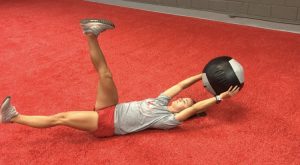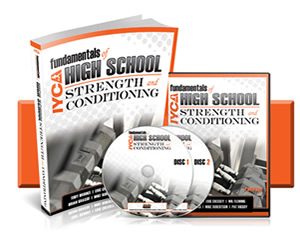When coaches hear the term “abdominal exercises,” they often think of movements such as basic sit-ups, Russian twists and crunches. While these exercises may create a feeling of working the abdominals, they do not train the core to do what it’s real job is: stabilization.
A stable core is a healthy core. It doesn’t always mean that it will look “shredded” (that has more to do with diet that exercise), but it can resist unwanted movement throughout the spine to protect the back. With proper core training, your athlete can learn to lock the spine into place during loaded exercises to ensure back safety, as well as correctly translate force through the lower body into the upper body.
Integrating a wide variety of anti-extension and anti-rotational exercises to your training can allow the athlete to create the motor patterns necessary to lock the core into proper position before executing movement and exercise.
Anti-extension and anti-rotation core exercises are important in every athletic setting, regardless of the sport. This training can ensure proper core bracing during loaded exercises throughout their training sessions, and can help athletes maintain posture and transfer forces when running, throwing, kicking and hitting. These exercises also allow for safer training as the athlete advances into more intense exercises.
Anti-Extension Core Exercises:
This is an important type of core training because it allows the individual to learn how to maintain a neutral spine position in overhead activities such as any overhead presses, or spinal loaded activities such as back squats. Maintaining a neutral spine during these activities is important for spinal safety because without proper core bracing, spinal injuries are more likely to occur.
Implementing these exercises helps the athlete to learn how to “set the spine” before initiating any movement and helps them learn how to translate core bracing into many dynamic movements in sport.
Dead Bug, Banded Dead Bug, Med ball Dead Bug

The Dead Bug is a great anti-extension core exercise because it forces the core to stay locked in place while the arms and legs move. The goal is to not allow for the small of the back to leave the floor while the arm and the leg extend.
You can progress the Dead Bug from a bent leg at 90-degrees to a straight leg Dead Bug. Med ball or band resisted Dead bug can also create a good resistance and challenge.
Plank/Side Plank-The most simple and effective core stability exercise. The plank can teach an individual how to control and brace their own body weight.
TRX Rollout– This is a great alternative to barbell rollouts that can be easily manipulated to make it easier or more difficult.
Tall Kneeling Band Extension- Great anti-extension variation for all athletes. This also forces an athlete to brace their core while pressing the band overhead.
Anti-Rotation Core Exercises:
Anti-rotation core exercises serve a great purpose in all athletes. Not only does it force the athlete to brace their core, but the lateral resistance forces the core to fire and resist against rotation.
Med ball seated side toss- This core exercise is explosive but also forces the athlete to brace their core against rotation when the med ball comes back off the wall. The goal is to keep the feet up and resist rotation as the ball comes back to opposite pocket area.
Paloff Press– This variation can be done in a tall kneeling or standing position. The individual will set the knees and hips in an athletic stance and press the band away until the arms are straight. The goal is to resist the rotation that the pulling band creates.
Cross Press- This can be done with a resistance band or cable machine, and in a tall kneeling or split stance position. The goal is to resist the rotation of the band during the press and stabilize the core against rotation.
1 Arm KB Anti-Rotation March– A more dynamic core stabilization- the goal is to resist against the one sided kettlebell while marching.
1 Arm KB Back Extension– This is a great 2-for-1 variation. While squeezing the glutes to keep the back at a parallel position, the individual must resist the rotation of the kettlebell by keeping the scapula retracted and the core locked in.
Use these exercises to help build spinal stability in your athletes. You don’t have to use them all in every workout. Insert one or two into your program, and start to build routines that address stabilization in multiple directions.
 Jordan Tingman – CSCS*, USAW L1, ACE CPT, CFL1 is a graduate of Washington State University with a B.S. in Sports Science with a Minor in Strength and Conditioning. She completed internships with the strength & conditioning programs at both Washington State University and Ohio State University, and is currently a Graduate Assistant S & C Coach at Eastern Washington University.
Jordan Tingman – CSCS*, USAW L1, ACE CPT, CFL1 is a graduate of Washington State University with a B.S. in Sports Science with a Minor in Strength and Conditioning. She completed internships with the strength & conditioning programs at both Washington State University and Ohio State University, and is currently a Graduate Assistant S & C Coach at Eastern Washington University.
The IYCA High School Strength & Conditioning Specialist is the only certification created specifically for coaches training high school athletes. The course includes several hours of video instruction and two textbooks with contributions from some of the top strength and conditioning coaches in America. Click on the image below to learn more about how to become a certified high school strength & conditioning coach.


